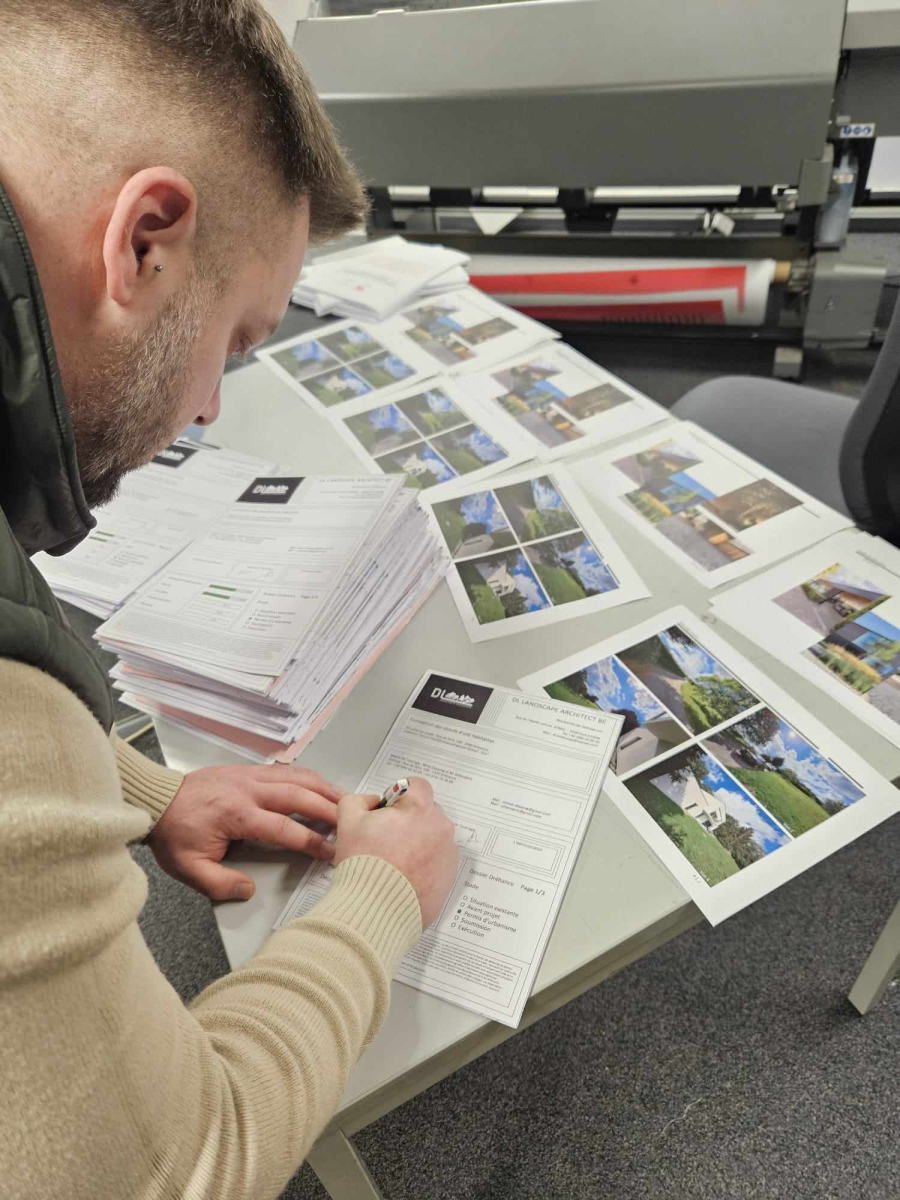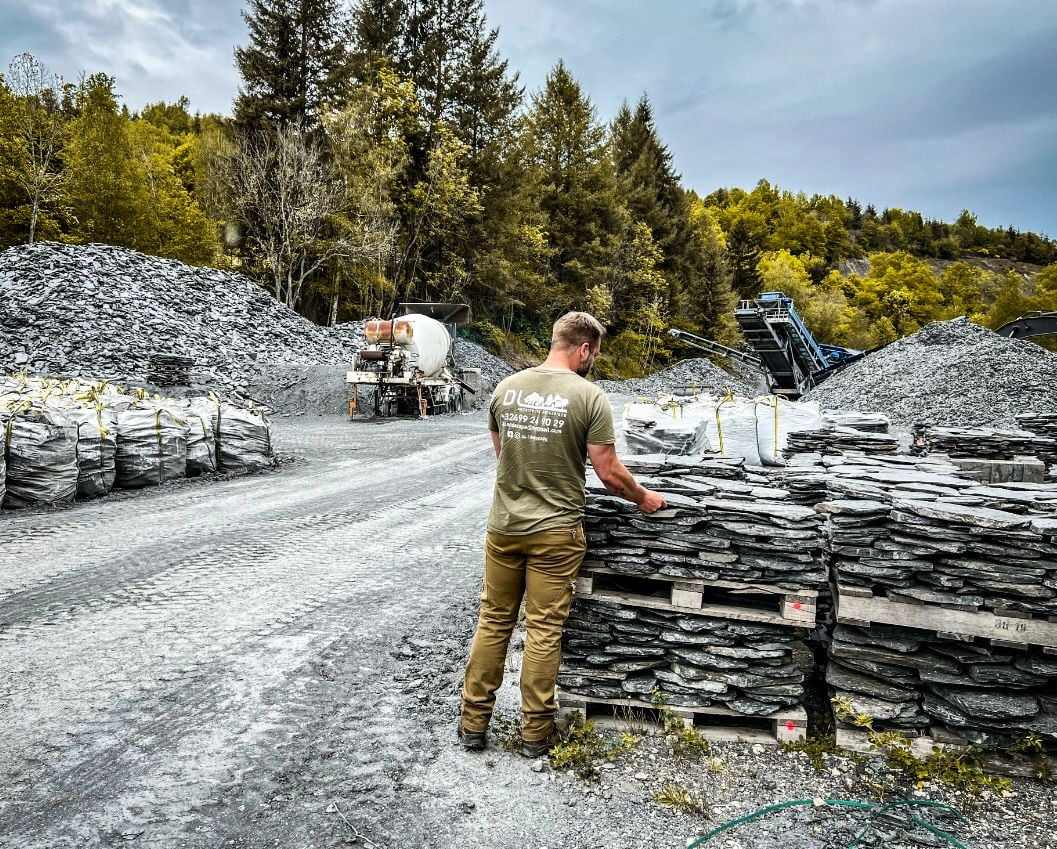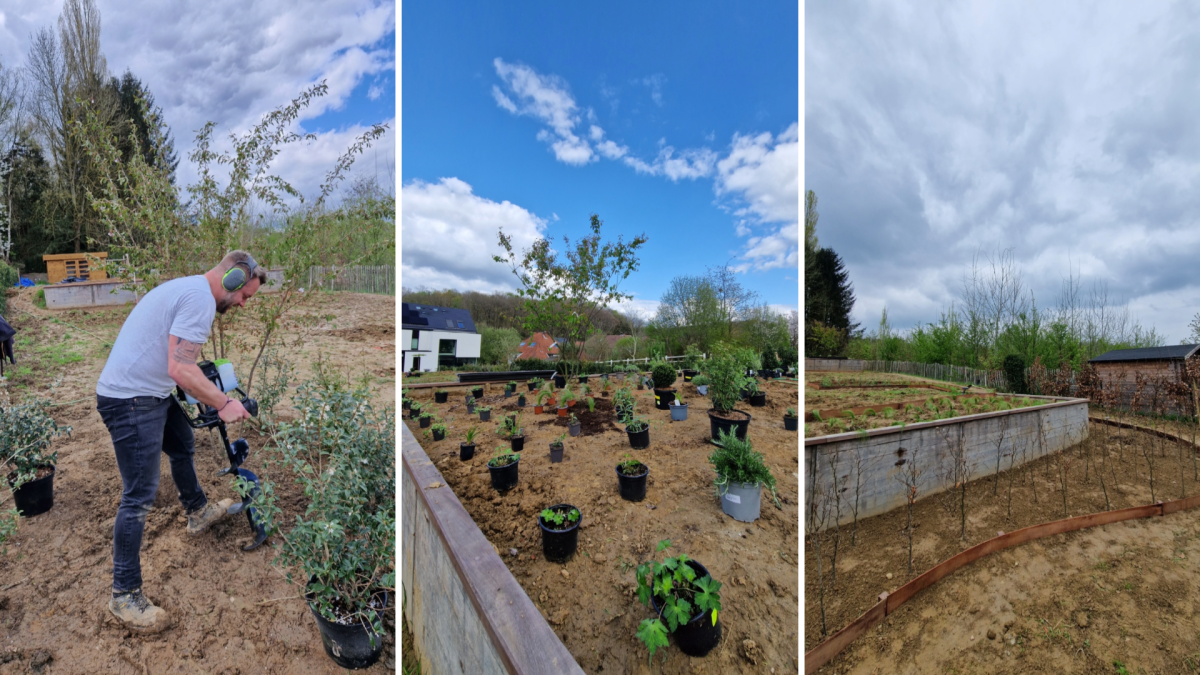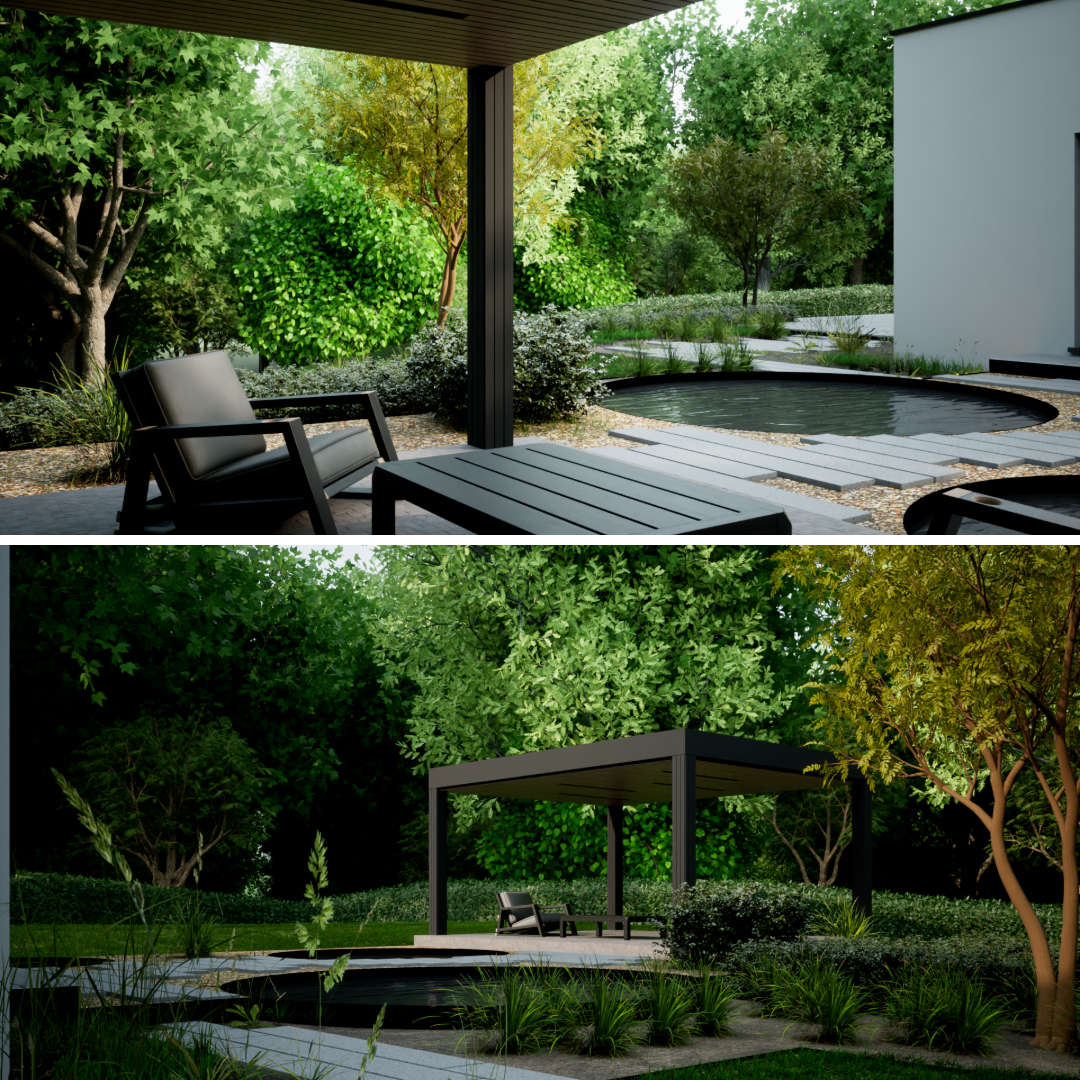- Home
- Redefining outdoor spaces in the era of climate change with an educational approach
Redefining outdoor spaces in the era of climate change with an educational approach
06/05/2024 - 09:32
We reached out to Loïc Delhaye, a landscape architect and frequent patron, to delve into his career journey and his exploration of TerraCottem. Since last November, Belgium and its neighbouring nations have been grappling with unrelenting rainfall, which has saturated the soil, complicating the use of heavy machinery on worksites. Nevertheless, this challenge presents a silver lining: it affords more office time. This period has provided Loïc with the opportunity to advance his research and reinvent his approach, enabling him to innovate within his field.
Hello Loïc, given that the weather doesn’t lend itself to building new gardens, it has fortuitously allowed us the chance to finally conduct this interview, something we've attempted to organize several times before. This relentless rainfall is yet another manifestation of climate change. How have you adapted your practices to address these environmental shifts?
 |
My perspective on climate has changed significantly, which has been a positive transformation. Five years ago, I updated much of my plant selection in response to ongoing climatic changes. Depending on the soil's existing condition and exposure, I now employ different soil management techniques. For areas with sunny exposure, I've adapted by incorporating plants typically found in the gardens of southern countries. I also alter the land's contour to create slopes, reducing water stagnation. To keep the soil cool and reduce maintenance, I use mulches like wood chips or lava stones, which also help suppress undesirable weeds. As far as maintenance is concerned, we typically carry out major maintenance works in March and then take it easy for the rest of the year, except for the weeding. |
And what about the trees?
Chestnut trees, depending on the variety, are gradually succumbing to threats like the Cameraria ohridella insect or the Pseudomonas syringae pv. Aesculi bacterium. Likewise, large oaks often fall prey to fungal diseases or attacks by Cynipidae insects. And the list goes on... and as a response, I'm transitioning from beech hedges to hornbeam (Carpinus betulus), which is better suited to these changes.
There’s also the problem of certain foreign imports, which sometimes carry parasites and cause damage that can be seen in our gardens, like the Box Tree Borer, for example. Fortunately, I collaborate with exceptional nurseries that offer a rich selection of traceable plants, each with its own passport.

And we must also consider new regulations regarding impermeable surfaces when designing gardens.
Working with impermeable soils is becoming increasingly restricted. We need to ensure water can seep through terraces and paving instead of being harvested. We can no longer harvest water; we have to return as much as possible to the soil, to the plants.
Wherever possible, we direct water back into the soil and plant beds. The aim is to reduce reliance on gutters, and to design garage entrances that are either grassed or constructed with permeable paving. Gradually, nature is reasserting its presence and rights.
The more we incorporate open, permeable areas, the more opportunities nature has to thrive—and I absolutely love this! I employ a low-growing grass that reaches a height of 5 to 7 cm. This height is manageable throughout the year and includes a brief flowering period, which benefits insects and improves access along paths.
What’s your background?
I’m 31 years old. I started my studies by chance. I spent a lot of time with my cousin, who works in horticulture in a social workshop. Ever since I was a child, I’ve been helping him with the vegetable garden and a bit of maintenance, and I’ve developed a taste for being out in nature.
I was also a footballer, so I was outside all the time.
I also loved drawing. At school I did science and then applied arts. I dabbled in everything: painting, drawing, charcoal, models and so on.
After finishing school, I hesitated between going to work straight away or going to college. As I didn’t know what to do, and as there are quite a few people in medicine in the family, I decided to do physiotherapy.
What a trajectory!
I did a year of physiotherapy, and passed, but it wasn’t my thing. It wasn’t what I wanted to do.
Another cousin of mine who is a landscape architect, suggested to me: “Since you enjoy the outdoors and have a passion for drawing, why not consider studying landscape architecture?”. So, I took his advice, and everything naturally fell into place. After three years, I graduated from CERIA and then began the daunting task of seeking employment. The field is so expansive that it's hard to know where to start. And here's a bit of a pun—while you're in school, they don't really outline all the different “branches” available within our profession.
After completing my studies, I joined the social workshop where my other cousin works. I began as a manager, overseeing 35 men during the busiest season for maintenance and creative projects. My role involved assigning tasks tailored to their abilities - some handled maintenance, while others took on smaller creation projects like mowing, light planting, or pruning. The team was diligent, punctual, and extremely respectful. Understanding their individual capabilities and limitations was crucial. It was a profoundly enriching experience, both professionally and socially. I spent a year in this role.
Then I was hired by a landscape architect who works in the Brussels region and who has both a maintenance company and a design office. I did both. During the day I did maintenance, and in the evenings and at weekends I drew up design plans for him. I did that for 5 years. I’m very grateful to him!
Last year in August we decided to go our separate ways. Given that I was already working as part-time freelancer and that I had quite a lot of work to do, I decided to become full-time self-employed. The transition went fairly smoothly. I work alone in the office and on site with a friend who is a contractor. Earthworks, paving, underpinning, planting, lawns and so on I do with an external company with whom I work closely. For more specific work, I call on the trades I know (pool builders, ironmongers, carpenters and even beekeepers!)
Are you happy with your decision?
Yes, I'm content, though the weather hasn't been cooperative. Given that my work typically requires more time in the field than in the office, the persistent rain has forced me indoors more than I'd like. This has prompted me to think about how I can enhance my visibility on social media in unique ways to stand out from the competition. The extra time indoors also allows me to conduct research through books, observations in nature, and online resources. Plus, I enjoy traveling to southern countries.
Which countries in particular?
I love Spain and Portugal and there are some really beautiful landscapes in the South of France and for creative ideas, not for the choice of plants, I like to take inspiration from Australia. That’s the direction I’m heading in.
So, these are more Mediterranean gardens.
Yes, we’re moving towards those gardens.
More use of gravel and less lawn?
No, as I said, I’m getting inspiration for the design.
Gravel is fine, but now with town planning, a slab, concrete or gravel is considered the same thing depending on the municipality. There has to be a balance between mineral and vegetal surfaces, permeable and impermeable, but if it’s not vegetal it’s considered an impermeable surface. This is starting to become more widespread.
|
|
|
|
But gravel is permeable.
Yes, it is. It’s crucial to strike the right balance while respecting urban planning guidelines. A balance between plants and minerals.
"That’s why I spend a lot of time on research, to stand out from the crowd and innovate, especially in terms of cost, given the recent rise in prices."
The quality of the design and creation is essential, so I look for solutions that respect the customer’s budget while offering a high-quality result.
Earlier on you told me that you’ve changed the range of plants in your designs. Where do you buy your plants?
Primarily from Holland and Italy. The Italians acclimatize plants by placing them in the mountains for a season so that they can adjust to the cooler climate. In Holland, there's a vast selection of plants, including new varieties that are either imported or developed locally. This diversity offers an excellent opportunity to distinguish oneself in the field.
Tell me about the terrace garden project?
We planted the entire back garden. There was an existing swimming pool. The main constraint of the project was that the land was on a steep slope, so the entire garden was built in different levels. We planted around 1,200 plants, trees, shrubs, grasses, perennials and bulbs. And all with TerraCottem, of course!
It’s important for the garden to be attractive 12 months out of 12.
 March 2023 |
 5 months later … |
This 3D project is a new project that has just been approved earlier this year.

It’s a huge project from A to Z: car park, car port, pergola, main terrace, secondary terrace, quite a lot of planting but discreet because we’re in the hills above Dinant. From the garden you have a view over the whole valley. I took inspiration from the surrounding area to keep things as discreet as possible.
How did you hear about TerraCottem?
At my supplier, La Plaine Chassart. And also at Willaert.
They had product samples on display and I took the blue one, TerraCottem universal.

That’s how I got started.
I’m glad to hear that the samples are being used.
Absolutely. In fact, I don’t just use them for testing - I use samples to demonstrate products to clients. They appreciate being able to see, touch, and understand the products firsthand. I enjoy working with various samples, including wood, stone, and even plant pots.
"TerraCottem doesn’t just save water, it also helps plants grow better. There are a lot of good points about this product. I know there’s a lot of research behind it. "
It’s a great product. I recommend TerraCottem most of the time. Some clients are reluctant; they prefer potting soil because they’ve known it for years and find it “hard to change”.
Some clients, particularly the one of the big project, take a very open approach. They are open to anything that will benefit their garden in the long term. This is precisely the case with TerraCottem, which not only improves the health of the garden, but also offers long-term benefits, such as reducing the need for watering. These customers understand the benefits of the product and take a long-term view.
Which TerraCottem do you use?
Arbor and universal. I started with universal like everyone else. Then I tried the TerraCottem arbor and I’m very happy with it. I use TerraCottem universal for small plants, perennials, grasses and small shrubs. I use arbor for large shrubs and trees.
What does TerraCottem mean to you in your work? How does it help you?
"The great thing about TerraCottem is that there’s a striking analogy with my work. As a landscape architect, I work behind the scenes: I’m behind my desk designing the plans, and although the finished product is visible, you can’t see who’s “hiding” behind the design. TerraCottem works in a similar way. It’s hidden in the ground, but its effect is evident in the splendour of the plants. I associate this product with my work because, although it remains invisible, the quality of our work is shown by the quality of the site and the brilliance of the plants. That’s how I see the impact of TerraCottem."
Do you also maintain the gardens you’ve created?
I stopped offering lawn-mowing and hedge-trimming services because the demand was too big. I now prefer to devote my time to landscape design. When I’m asked to, I offer to assist my clients in the first maintenance; it’s an aspect of my work that I particularly enjoy. Many of my clients prefer to tend their gardens themselves, and I've had the pleasure of planting alongside them. I'm keen to expand this educational approach, helping clients not only recognize plant names and the visual aspects of their garden beds but also understand the specific planting techniques suited to different types of plants, whether they be evergreens, roses, or grasses. It’s crucial for clients to grasp how their garden functions, including the best times and methods for watering.
This is something I’d like to develop further. It all started very simply, when a customer asked me: “Can I do the planting with you?" I really enjoyed the experience.
It’s a good idea to get clients involved. They’ll be more interested in looking after their garden.
Indeed, they’ll take better care of it. What I particularly appreciate is the social aspect that I developed thanks to my first work experience in the social workshop. Unconsciously, that first job opened up new perspectives in my mind. When the opportunity arose, I was ready for it, having learnt a lot from the people I had worked with.
What are your main challenges on construction sites?
That depends on the project. To be honest, I never use the same selection of plants. It depends on the project and the customer’s terrain. I want the customer to be surprised in a positive way.

What region do you work in?
I primarily operate in the Brussels, Charleroi, Liège, and Wavre areas, though my work extends beyond Belgium. Recently, I was approached for a project in France, and I'm hopeful that future requests will come from even further afield. My aspiration is to expand my reach internationally. Traveling for work not only fuels my curiosity but also drives my professional growth.
What channels do you use to increase your visibility?
Social media offer a lot of free visibility. However, even more decisive are my personal and professional networks: friends, old contacts, word of mouth, as well as collaborations with other professionals, such as architectural firms. One of these firms opened a significant door for me by entrusting me with a public project in an annex of the industrial zone at Charleroi airport. This area, which is still under development, plans to construct a number of large-scale industrial buildings. These architectural firms, renowned for their involvement in energy-efficient building projects, are key partners in securing such projects.
Relationships are very important. The customer is very important, but so are the suppliers and the people around them.
What’s your motto?
I have two mottos.
The first is:
“The best time to plant a tree was more than 20 years ago, the second best time is now”.
The second is that we must never rest on our laurels. We must constantly evolve. I’ve been told from an early age that I’m very curious. I like to understand how things are made, how they fit together, how they work. Observation and curiosity are the key. For example: Did you know that over 90% of plants are edible?
Do you have a favourite tree or plant?
I've had a passion for cacti since childhood, but when it comes to garden trees, my favourite is the Amelanchier lamarckii. This native tree captivates interest throughout the year. It ushers in spring with a flourish of white blossoms, followed closely by the emergence of its leaves. As the seasons change, its foliage transitions through shades of dark green and orange-green, before shedding its leaves to bloom anew. Its distinctive, multi-trunked silhouette makes it a superb choice for small gardens. Amelanchier lamarckii is not only easy to care for but it is also robust. I frequently incorporate it into projects where it fits the aesthetic. Truly, it’s a magnificent tree!

Is this tree Loïc’s signature?
Loïc’s signature... in a way, yes. I use it quite often. It’s my favourite small tree. It may not be exceptional for others, but for me it’s interesting for all four seasons. Often that’s what the customer is looking for. I also work a lot with bulbs, which flower throughout the year. I like a garden to be lively all year round.
Any tips?
Call me (laughs)! It’s better to call us one year “too early” than one month too late. The design of the surroundings of your home, offices, shops, etc. is based on clearly defined stages, just like their implementation.
For a new build and/or renovation of a garden, I recommend that you call on our services at the preliminary design stage with your architect, so that we can work together and avoid any minor surprises.
For “existing” gardens, don’t waste any time. If the work is done while nature is dormant, your garden will shine during the holidays.
More information about DL Landscape?
If you know someone who would also like to read this article, feel free to copy the link and share.
Would you like to be in the spotlight too?
You can!
Send a quick email to marketing@terracottem.be and we will schedule an online meeting together.
Would you also like to use TerraCottem in your projects?
Contact usWould you also like to use TerraCottem in your projects?
Contact usTerraCottem Intl. SL
Apartado de Correos 4511190 Benalup (Cádiz)Spain





